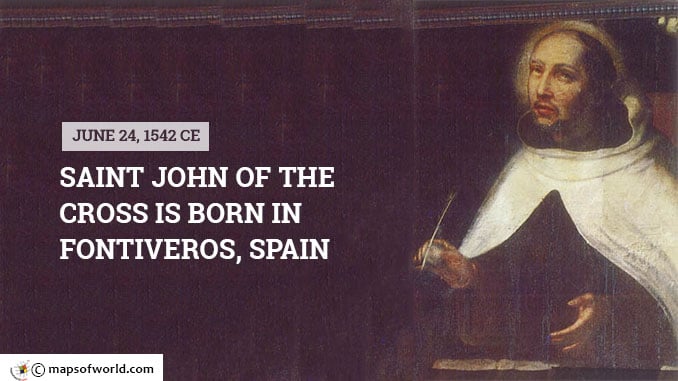A little more than 80 miles to the northwest of Madrid, the quiet village of Fontiveros was little more than a map dot on the Spanish plains on June 24, 1542. On this day in history, the tiny community welcomed a baby boy by the name of Juan de Yepes Alvarez, who would grow to be one of the foremost figures in the Counter-Reformation and a pillar in Spain’s literary tradition. Born into a converso family, meaning they had been Jewish at one time, John came to grips with the life of poverty he would eventually lead as a priest during childhood. His mother, widowed by her husband’s untimely death, moved John and his two brothers from town to town in the province of Castile, finally settling in Medina del Campo around 1551. Each member of the family had to work to ensure survival, with John helping out in a hospital. At the age of 17, John began attending a tiny school from a relatively new Catholic order: the Jesuits. During four years at the Society of Jesus school, it became clear to him that his life’s call would lead him into the ministry. Near the end of February 1563, he was initiated into the Carmelite order, officially entering the novitiate as Friar Juan de Santo Matía and earning full acceptance in a year’s time. No longer regarded as a novice, John moved to Salamanca – and thrived. Coming under the tutelage of the Augustinian friar Luis de León, he buried himself in the study of theology and philosophy at two nearby colleges. Connecting with León, one of the world’s premier experts in biblical studies, would turn out to be one of the most formative experiences in John’s life. With three years’ study completed, John received ordination as a priest and decided to join the Carthusian order, drawn to its reputation for quiet reflection and rigid discipline. He would never make it. Stopping in his hometown of Medina del Campo, he crossed paths with a woman by the name of Teresa de Jesús, a woman obsessed with making changes in the Carmelite order to bring it more in line with Scripture. In 1568, he settled in Duruelo to help these reformations take root there, working for nearly a decade founding and governing monasteries alongside Teresa de Jesús – the future St. Teresa de Avila – before his arrest in 1577 for defying instructions to return to the Carmelite house he had been a part of. Over the course of nine months leading up to his escape in August 1578, the seeds of John’s education began to bear fruit. Squeezed into a tiny cell and forced to endure public whippings at least once a week, he began composing the Spiritual Canticle, the first of his two famous poems contemplating the nature of the soul in this life. (The later work, Dark Night of the Soul, would become more popular.) After breaking free, John returned to a life much like the one he had before being jailed. Now working to spread the influence of the Discalced (“Barefoot”) Carmelites further, he continued founding monasteries and writing extensively. His four treatises, particularly Ascent of Mount Carmel, would come to be recognized as key texts in Catholic mysticism, capturing the minds of such diverse thinkers as T.S. Eliot, Thomas Merton and Salvador Dali. In late 1591, at the age of 49, John succumbed to the effects of a strep infection. One hundred and thirty-five years later, he was canonized by Pope Benedict XII. Then, two centuries after achieving sainthood, Pope Pius XI declared him a Doctor of the Church, an honor distinguished for those who have advanced the Catholic understanding of theology or doctrine.
June 24, 1542 CE – Saint John of the Cross is Born in Fontiveros, Spain
A little more than 80 miles to the northwest of Madrid, the quiet village of Fontiveros was little more than a map dot on the Spanish plains on June 24,…
